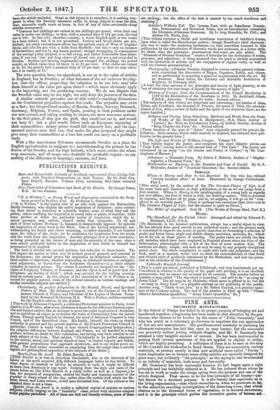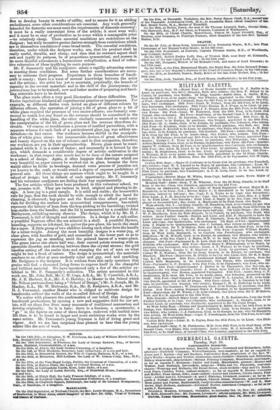FINE ARTS.
DECORATIVE MANUFACTURES.
IF the School of Design has failed in its proper purpose of bringing art and handicraft together, a beginning has been made in that direction by the gen tleman who chooses to be known by the name of " Felix Summerly," and who has acted as a voluntary go-between to negotiate the coy approaches of fine art and manufacture. His goodhumoured assiduity in pursuing his dilettante enterprise has laid him open to easy banter; but the successful can generally endure jesting without chagrin, and Mr. F. Summerly has attained a very tangible amount of success. He has been instrumental in putting forth several specimens of fine art applied to objects of utility, which are highly promising. A collection of them is to be seen at the shop of Mr. Cundall the bookseller in Bond Street. They are executed in various materials, at present mostly in that new artificial stone called " Parian "; some duplicates are in bronze; some of the articles are specially designed for glass ware; but evidently " the principle," as the saying is, can be extended to an infinity of materials, both more and less costly.
Mr. Summerly has been successful because he had began upon a right principle and has faithfully adhered to it. He has induced those whom he has set to work to make the design spring from the purpose and use of the article designed. That seems to be the true principle of all beauty—per- fect fitness for a destined purpose. It is the beauty that captivates us in the living organization,—that which reconciles us, when we penetrate so far, to the otherwise revolting investigations of the dissecting-room; that which charms us in the thousand forms of vegetation, or in mineral structures; and it is the principle which guides the inventive genius of human art.
But to develop beauty in works of utility, and to secure for it an abiding embodiment, some other considerations are essential. Any work generally intended for domestic use must meet the requirements of domestic economy: it must be a really convenient form of the article; it must wear well; and it must be so easy of production as to come within a manageable price —be relatively cheap. These essential conditions are restrictions on the designer; but truly inventive genius derives strength from restrictions which are in themselves conditions of some broad truth. The essential conditions, therefore, under which the designer works, are, that his product shall be really useful, durable, and cheap; and then that its outward aspect shall suit and typify its purpose, be of proportions symmetrical, and possess in its more fanciful adornments a harmonious reduplication, a kind of reflec- tive reiteration of ideas typifying its main purpose.
Mr. F. Summerly and his coadjutors attain a rapidly-advancing success in meeting these conditions. But some further considerations are neces- sary to estimate their progress. Experience in these branches of handi- craft is scanty: there is a want of mutual knowledge between the artist and the artisan ; the artist has yet to ascertain, practically, the bounds of capacity in the several materials and in the skill of the journeyman; the journeyman has to be trained; new and better modes of preparing and hand- ling materials have to be devised.
The glass trade offers a very good illustration of these difficulties. The Excise regulations hindered all experimental practice or improvement. For example, as different duties were levied on glass of different colours by different officers, the operation of joining a bit of green glass to a bit of white glass required the presence of two excise-officers; one formally sum- moned to watch lest any fraud on the revenue should be committed in the handling of the white glass, the other similarly summoned to watch over the manipulation of the bit of green glass and the revenue therefrom de- rivable. Of coarse, so troublesome a process of testified parturition, with a separate witness for each limb of a particoloured glass jug, was seldom un- dertaken—in fact never. Our workmen became skilful in the manipula- tion of white glass alone: but innumerable devices of great effectiveness and beauty depend on the use of colours; and in that occupation, therefore, our workmen are yet in their apprenticeship. Blown glass must be mani- pulated while it is in a state of fusion; and necessarily it is formed by the eye, which demands a considerable degree of artistic cultivation in the workman: in that respect also much has to be done of the nature assigned to a school of design. Again, it often happens that drawings which are very beautiful on paper cannot be worked out in glass, because the form would either be liable to breakage, demand some process of junction not yet known to the craft, or would entail a degree of expense prohibitory of general sale. All these things are matters which ought to be taught in a school of design; but in default of such opportunity, Mr. F. Summerly and his volunteer coadjutors are feeling their way experimentally.
The few articles which have been produced in this volunteer school, we say, promise well. They are various in kind, original and pleasing in de- sign. A beer-jug is a good sample. It is solid and stable; the housewife's rale for jugs, that the neck should be wide enough to admit the hand for cleaning, is observed; hop-poles and the Kentish vine afford good mate- rials for dividing the surface into symmetrical compartments; bas-reliefs represent the history of beer, from the hop-picking to the barrelling; twisted hop-stalks form the handle; and the lid. is surmounted by a youthful John Barleycorn, rollicking among sheaves. The design, which is by Mr. H. J. Townsend, is full of thought and animation. In a design for a salt-cellar, a-youthful Neptune offers the sea mineral in a shell. A youthful Hymen, kneeling, supports an inkstand, his quiver the pen-place, his torch the stand fora taper. A little group of two children kissing each other form the handle for a letter-weight. Among the most beautiful designs is a water-jug, of clear glass, with handles of gold, and enamelled in the lower part so as to represent the jug as standing amid the pointed leaves of a water-plant. The green leaves rise above half way, their curved points crossing with an agreeable disorder, and showing between them the crystal stream; the gold handles setting off the cooler tints and stamping the art of man on what might be but a freak of nature. The design is symmetrical; the materials conduce to an effect at once modestly sober and gay, cool and sparkling. Mr. Redgrave is the designer. It is evident from this early specimen that genius will find a thousand living forms to express itself in the changeful and brilliant material. We have mentioned only a few of the articles ex- hibited in Mr. F. Snmmerly's collection. The artists associated in this work are, Mr. John Bell, Mr. C. W. Cope, A.R.A., Mr. T. Creswick, A.R.A., Mr. J. R. Herbert, R.A., Mr. J. C. Horsley, (a Master in the School which Mr. Wilson prevents from being a" School of Design,") Mr. S. Joseph, Mr. D. Maclise, R.A., Mr. W. Mulready, R.A., Mr. R. Redgrave, A.R.A., and Mr. H. J. Townsend, another Master who is obliged to cultivate design for handicrafts without the walls of the so-called School of Design.
We notice with pleasure the confirmation of our belief, that designs for handicraft productions, by opening a new and suggestive field for our art- ists, will set them free from many trammels of traditional mannerism and develop originality. So it is here: there is a freedom, a spontaneity, a " go " in the figures on some of these design; endowed with tenfold more We than is to be found in larger and more ambitions works even by the same artists. Mr. Townsend's young Neptune is full of living grace and vigour. And we are less surprised than pleased to hear that the young artists like the sort of work.



























 Previous page
Previous page